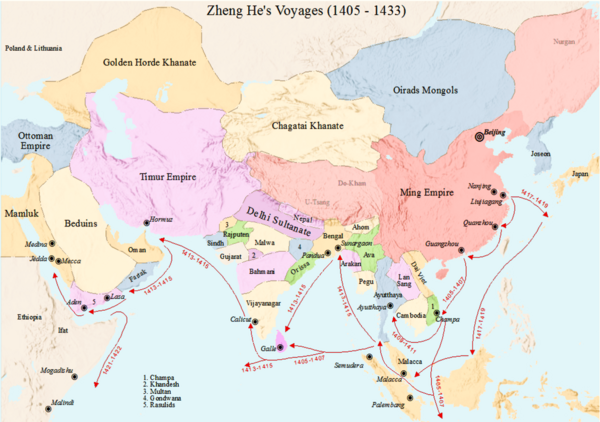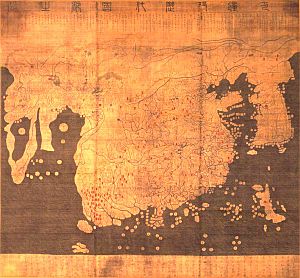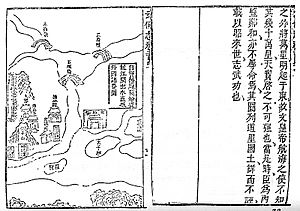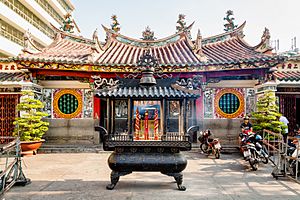Zheng He facts for kids
Quick facts for kids
Zheng He
|
|
|---|---|
| 鄭和 | |
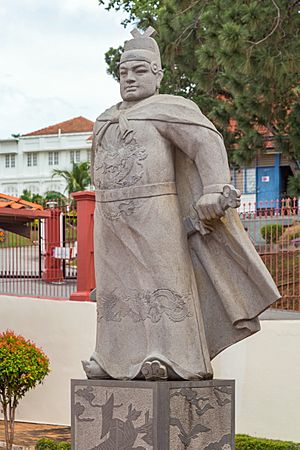
Statue from a modern monument to Zheng He at the Stadthuys Museum in Malacca City, Malaysia
|
|
| Born |
Ma He
1371 Kunming, Yunnan, Yuan (Prince of Liang)
|
| Died | 1433 (aged 61–62) or 1435 (aged 63–64) |
| Other names | Ma He Ma Sanbao Cheng Ho |
| Occupation | Admiral, diplomat, explorer, and palace eunuch |
| Era | Ming dynasty |
| Zheng He | |||||||||||||||||||||||||||
|---|---|---|---|---|---|---|---|---|---|---|---|---|---|---|---|---|---|---|---|---|---|---|---|---|---|---|---|

Zheng's name in Traditional (top) and Simplified (bottom) Chinese characters
|
|||||||||||||||||||||||||||
| Traditional Chinese | 鄭和 | ||||||||||||||||||||||||||
| Simplified Chinese | 郑和 | ||||||||||||||||||||||||||
|
|||||||||||||||||||||||||||
Zheng He (simplified Chinese: 郑和; traditional Chinese: 鄭和; pinyin: Zhènghé; Wade–Giles: Chêng-ho; 1371–1433 or 1435) was a famous Chinese sailor, explorer, and fleet admiral. He lived during China's early Ming dynasty. Many people think he was the greatest sailor in Chinese History.
He was born as Ma He into a Muslim family. Later, the Yongle Emperor gave him the new family name Zheng. The Yongle Emperor and later the Xuande Emperor sent Zheng He on seven amazing treasure voyages. These trips went to Southeast Asia, South Asia, West Asia, and East Africa. They happened between 1405 and 1433. Legend says his biggest ships were huge. They carried hundreds of sailors and were almost twice as long as any other wooden ship ever known!
Zheng He was a favorite of the Yongle Emperor. He helped the emperor take power from the Jianwen Emperor. Because of this, Zheng He rose to a very high position in the government. He even became the commander of the southern capital, Nanjing.
Contents
Early Life and Family Background
Zheng He was born as Ma He (馬和) in 1371. His family was Muslim and lived in Kunyang, Kunming, in the Yunnan region of China. He had an older brother and four sisters.
As an adult, Zheng He had many different religious beliefs. Records show he especially honored Tianfei. She was the goddess who protected sailors and people traveling by sea. This shows how important she was to the treasure fleet.
Zheng He's great-great-great-grandfather was Sayyid Ajjal Shams al-Din Omar. He was a leader in the Mongol Empire and governed Yunnan during the early Yuan dynasty. Zheng He's grandfather and father both had the title hajji. This means they had made the pilgrimage to Mecca, a holy trip for Muslims.
In 1381, the Ming army invaded and conquered Yunnan. The Mongol prince Basalawarmi ruled Yunnan at that time. Zheng He's father, Ma Hajji, died in the fighting between the Ming and Mongol armies. Zheng He's older brother buried their father outside Kunming. Years later, as an Admiral, Zheng He had a special stone carved to honor his father.
Capture and Service to the Emperor
Zheng He was captured by the Ming armies in Yunnan in 1381. He was taken to serve in the household of Zhu Di. Zhu Di was the Prince of Yan and later became the Yongle Emperor. Zhu Di was eleven years older than Ma He.
Ma He became a trusted servant to Zhu Di. He spent his early life as a soldier on the northern border. He often fought in Zhu Di's wars against the Mongols. In 1390, Ma He went with the Prince on his first big military trip. It was a great victory.
Ma He earned the prince's trust. He was also known as "Sanbao" (meaning "Three Jewels" or "Three Protections"). Ma He received a good education in Beiping (later Beijing). This was important because the emperor at the time, the Hongwu Emperor, did not trust palace servants and wanted them to be unable to read or write.
Becoming an Admiral and Later Career
Zheng He grew to be a tall man, about 7 chi (around 2 meters or 6.5 feet) tall. He had a strong build and a loud voice. He was also very knowledgeable about warfare and experienced in battle.
He became a close advisor to Prince Zhu Di. He helped the prince during a war called the Jingnan Campaign (1399–1402). This war ended with Zhu Di becoming the new emperor, the Yongle Emperor. In 1399, Ma He bravely defended Beiping's water supply against the emperor's armies. In 1402, Zheng He was one of the commanders when Zhu Di's armies captured the capital city, Nanjing.
After becoming emperor, Zhu Di gave Ma He the new family name "Zheng" in 1404. This was to honor him for his bravery in defending Beiping and for his help in capturing Nanjing. Zheng He was also promoted to a very high position called Grand Director.
In his new role, Zheng He became the Chief Envoy for his sea voyages. Over the next 30 years, he led seven voyages for the emperor. These trips were for trading and collecting gifts from other countries in the eastern Pacific and Indian Oceans.
In 1424, Zheng He traveled to Palembang in Sumatra. He delivered an official seal and letter to a local leader. When he returned, he learned that the Yongle Emperor had died.
The new emperor, the Hongxi Emperor, stopped the treasure voyages in 1424. In 1425, he made Zheng He the defender of Nanjing. Zheng He was ordered to keep commanding the treasure fleet for the city's protection. In 1428, the Xuande Emperor (Hongxi's son) asked Zheng He to oversee the rebuilding of the Great Bao'en Temple in Nanjing. He finished the temple in 1431.
In 1430, the Xuande Emperor decided to send Zheng He on a seventh and final expedition. This trip was to the "Western Ocean" (Indian Ocean). In 1431, Zheng He was given the special title Sanbao Taijian, using his informal name Sanbao.
Amazing Expeditions
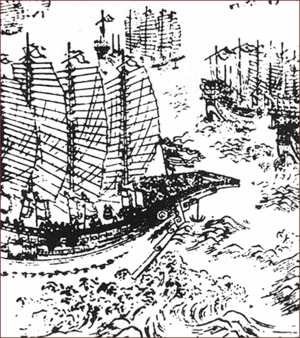
The Chinese had learned a lot about the world before Zheng He. Maps from the 14th century showed more and more of Arabia and Africa. Between 1405 and 1433, the Ming government sent out seven huge naval expeditions. The Yongle Emperor wanted to show China's power and control trade in the Indian Ocean. He also wanted to impress foreign people and expand China's system of collecting tribute. Some historians also believe the first voyages were to find the emperor who had been overthrown.
Zheng He was the admiral in charge of this massive fleet and its armed forces. His first voyage left on July 11, 1405, from Suzhou. The fleet had 317 ships and almost 28,000 crew members!
Zheng He's fleets visited many places, including Brunei, Java, Siam (Thailand), Southeast Asia, India, the Horn of Africa, and Arabia. They exchanged goods along the way. Zheng He gave gifts like gold, silver, porcelain, and silk. In return, China received interesting new things like ostriches, zebras, camels, and ivory from the Swahili Coast. He even brought back a giraffe from Malindi. People thought it was a mythical creature called a qilin.
While Zheng He's fleet was huge, the routes they took were not new. His ships followed old trade paths between China and the Arabian Peninsula. These routes had been used for a very long time, even since the Han dynasty. When his fleet first arrived at Malacca, there was already a large Chinese community there. A translator named Ma Huan wrote detailed accounts of the people and customs in the ports they visited.
Zheng He usually tried to achieve his goals through peaceful talks. His large army often made other groups agree without fighting. However, he was not afraid to use force if he thought it was needed to show China's military strength. He fought against pirates who caused trouble in Chinese and Southeast Asian waters. For example, he defeated a famous pirate captain named Chen Zuyi and sent him back to China to be punished. He also fought a land war in Ceylon and showed military force when local leaders threatened his fleet in Arabia and East Africa. After his fourth voyage, he brought leaders from 30 different countries to China. They visited the Ming court and showed their respect.
In 1424, the Yongle Emperor died. His son, the Hongxi Emperor, stopped the voyages during his short time as ruler. Zheng He made one more voyage during the reign of Hongxi's son, the Xuande Emperor. After that, the voyages of the Chinese treasure fleets ended. The voyages went against the rules set by the first Ming emperor, the Hongwu Emperor. He believed that distant countries should not have to spend too much to send tribute.
Zheng He likely died during his last voyage. Even though he has a tomb in China, it is empty because he was buried at sea.
Zheng He led seven expeditions to the "Western" or Indian Ocean. He brought back many treasures and leaders from over thirty kingdoms to China. This included King Vira Alakeshwara of Ceylon. He came to China as a captive to apologize for his actions against Zheng He's mission.
Zheng He wrote about his travels: "We have traveled over 100,000 li (a very long distance) across huge oceans. We have seen giant waves like mountains reaching the sky. We have seen faraway lands hidden in a blue mist. Our sails, spread out like clouds day and night, kept us moving as fast as a star. We crossed those wild waves as if we were walking on a public road..."
Sailing Charts and Maps
Zheng He's sailing charts, called the Mao Kun map, were published in a book in 1628. These maps were based on Zheng He's and earlier voyages. The original map was a long strip that could be rolled up. It showed different areas at different scales.
These maps were not like modern maps. They were designed for sailing. They gave directions using a 24-point compass system and included sailing times or distances. These times considered local currents and winds. Sometimes, they even showed how deep the water was. The maps also showed bays, rivers, capes, islands, ports, mountains, and important landmarks like temples. More than 80% of the places named outside China can still be found today.
Size of Ships
Stories from a novel written in 1597 describe the ships of Zheng He's first expedition:
- "Treasure ships" (宝船, Bǎo Chuán): These were the largest, with nine masts. They were about 127 meters (417 feet) long and 52 meters (171 feet) wide.
- Equine ships (馬船, Mǎ Chuán): These carried horses and goods. They had eight masts and were about 103 meters (338 feet) long and 42 meters (138 feet) wide.
- Supply ships (粮船, Liáng Chuán): These carried food for the crew. They had seven masts and were about 78 meters (256 feet) long and 35 meters (115 feet) wide.
- Transport ships (坐船, Zuò Chuán): These had six masts and were about 67 meters (220 feet) long and 25 meters (82 feet) wide.
- Warships (战船, Zhàn Chuán): These had five masts and were about 50 meters (164 feet) long.
On these ships were navigators, explorers, sailors, doctors, workers, soldiers, and translators. Six more expeditions happened from 1407 to 1433, with fleets thought to be similar in size.
Some historians believe the largest "treasure ships" were not actually used for ocean voyages. They think these huge ships might have been used by the Emperor and officials to travel on the calmer waters of the Yangtze River. Zheng He, as a palace servant, might not have been allowed to command the very largest ships. The main ships of his fleet were likely smaller, but still very large.
There is some debate among experts about the exact size of Zheng He's largest ships. Some records from the 17th century mention European ships being very long, which makes the claims about Zheng He's ships seem more believable. However, the exact measurement unit (zhang) used in the Ming era might have been different from what we think today. If the zhang was a shorter unit, then Zheng He's ships would have been smaller than the most extreme claims.
Shipyard Discoveries
From 2003 to 2004, archaeologists dug up parts of the Treasure Shipyard in Nanjing. This is where Zheng He's fleet was believed to have been built. They found three long basins. These basins were long enough for the largest claimed ships but not wide enough. They were also not very deep. Other ship remains suggest the ships were not as big as some stories say.
Archaeologists also found two complete wooden rudderposts. These were about 10 to 11 meters (33 to 36 feet) long. Some people thought these proved the ships were enormous. However, experts point out that traditional Chinese ships needed long rudderposts to reach from the water to the deck. Modern wooden ships of much smaller size also have very long rudderposts. So, the rudderposts alone don't prove the ships were gigantic.
Death and Legacy
One idea is that Admiral Zheng He died in 1433, during or soon after his seventh voyage. Another idea is that he continued to serve as the defender of Nanjing and died in 1435.
A tomb was built for Zheng He in Nanjing. It is a cenotaph, meaning it's a monument where his body is not actually buried. It is believed to contain his clothes and hat. In 1985, the tomb was rebuilt in a Muslim style. His body was likely buried at sea off the Malabar Coast near Calicut, in western India.
Impact in China
For a long time, Zheng He's voyages were not given much attention in official Chinese histories. However, they became well known again after a book about him was published in 1904.
After Zheng He's voyages, China's naval efforts supported by the government greatly decreased. In the 15th century, China faced growing threats from the Mongols in the north. Moving the capital to Beijing in the north made this threat even bigger. China spent a lot of money on military trips to weaken the Mongols. This meant less money for naval expeditions. Also, in 1449, the Mongols captured the emperor during a battle. This caused a big political crisis in China. After this, China stopped sending yearly land expeditions and instead built a huge, expensive Great Wall of China. In this situation, there was no money left for naval expeditions.
However, countries from Southeast Asia continued to send missions to China for decades. Sometimes, they came so often that the Chinese court had to limit them.
Influence in Southeast Asia
Among Chinese people living in Southeast Asia, Zheng He became a respected figure. Temples dedicated to him are found there.
After Zheng He arrived in Malacca, the sultan and sultana of Malacca visited China with over 540 of their people. They brought many gifts. Later, the Sultan of Malacca asked for a Chinese princess to marry him. Stories say that in 1459, a princess named Hang Li Po was sent from China to marry the sultan. She came with 500 young men and hundreds of handmaidens. They settled in Bukit Cina. Many of them married local people, creating the group known today as the Peranakan.
Indonesia
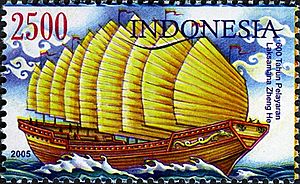
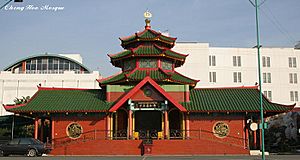
The Chinese Indonesian community has built temples dedicated to Zheng He in several cities, including Jakarta and Surabaya.
In 1961, an Indonesian Islamic scholar named Hamka said that Zheng He played an important role in spreading Islam in Indonesia. Some believe Zheng He helped build Chinese Muslim communities in places like Palembang and along the shores of Java.
Modern Views
In the 1950s, historians like John Fairbank and Joseph Needham suggested that China turned away from the seas after Zheng He's voyages. They thought China became isolated from European technology. However, modern historians say that Chinese sea trade did not completely stop after Zheng He. Chinese ships continued to trade in Southeast Asia, India, and East Africa for a long time.
Historians also point out that Zheng He's voyages ended for practical reasons, not because China lacked technology. Although the Ming dynasty had a rule against sea travel, it was often ignored. However, the neglect of the imperial navy after Zheng He's voyages made the coast vulnerable to Japanese pirates in the 16th century.
Richard von Glahn, a professor of Chinese history, believes that many stories about Zheng He focus too much on what China "missed out on." He argues that "Zheng He reshaped Asia" because his voyages had a huge impact on maritime history in the 15th century.
Cultural Impact
Even though his voyages were officially overlooked for a while, Zheng He's adventures captured the imagination of some Chinese writers. They wrote novels about his trips.
On his travels, Zheng He built mosques and helped spread the worship of Mazu. He never made a pilgrimage to Mecca himself, but he sent sailors there on his last voyage. He was very important in building relationships between China and Islamic countries.
Today, interest in Zheng He has grown a lot. He has been featured in science fiction novels, TV series, and video games. A Chinese training ship and a Taiwanese missile frigate are named after him. Even a planned space mission to explore an asteroid was originally named ZhengHe.
Important Relics
- Zheng He built the Tianfei Palace (Chinese: 天妃宫; pinyin: Tiānfēigōng; literally "Palace of the Celestial Wife") in Nanjing. This temple honored the goddess Mazu after his first voyage in 1407.
- A stone tablet called the "Deed of Foreign Connection and Exchange" (通番事跡) is located in the Tianfei Palace in Liuhe, Taicang. This is where the expeditions first started.
- Zheng He and his friends also rebuilt the Tianfei Palace in Changle County, Fujian Province. They put up a stone tablet there, talking about their earlier voyages.
- The Galle Trilingual Inscription in Sri Lanka was found in 1911. It is written in Chinese, Tamil, and Persian. It praises Buddha and describes the fleet's gifts to a famous temple.
- Zheng He's tomb in Nanjing has been repaired, and a small museum is next to it. But as mentioned, his body was buried at sea.
- Seven large sunken ships believed to be from Zheng He's fleet were found near Dongsha Island.
Images for kids
-
Zheng He's tomb in Nanjing
See also
 In Spanish: Zheng He para niños
In Spanish: Zheng He para niños



